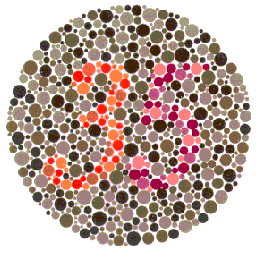| Why
can't men dress themselves?
Martin
Drinkwater
Ever wondered why men
can’t seem to colour co-ordinate their clothes? Perhaps
they are colour blind.
In the retina at the back of our eyes, there are millions
of cone cells. The cone cells have three different pigments,
each of which is a type of amino acid.
When you look at an object, the colours that you see are
those being reflected from the object. Much of the light
in the visible spectrum is absorbed in objects around
us, though, rather than reflecting. When a small portion
of the reflected light hits a pigment in your eye, it
is converted into an electrical signal. The signal is
carried through nerves to the brain so that we perceive
the light as being a mixture of red, green and blue. The
colours that we see depend on this interaction between
the eye and the brain. Like radio stations, each colour
corresponds to an exact frequency of light.
What happens then if the brain receives the wrong signal?
As with static, which represents errant signals on the
radio, colours in the eye can appear distorted. Consistent
distortion occurs for those with colour blindness. People
who are colour blind have
missing or abnormal pigments, making them 'colour deficient'.
Colour deficiency results in them being sensitive to light
of different frequencies than those associated with 'normal'
vision. So, might see a common colour as some colour different
to what others see, and they may lose the ability to distinguish
between colours.
 |
 |
Take
a look at the picture.
Those
with ‘normal’ vision will see the number 35.
People suffering from colour vision deficiency
will only be able to see either the 3 or 5.
Ishihara
test for colour blindness
|
 |
The most prevalent
form of colour vision deficiency is "Red-Green". People
with this condition are not blind to colour; they just
see red and/or green as different things. For example,
a red traffic light might look orange, green grass may
become indistinguishable from brown.
Other forms of colour vision deficiency can also occur,
as well as problems with light sensitivity. Total colour
blindness (where vision is in monochrome, meaning black,
grey and white) is extremely rare, affecting only about
three in every million people.
There are a
number of tests for colour vision deficiency. One of the
most common is the Ishihara test, which relies on being
able to distinguish numbers from a coloured background.
Take a look
at the picture. Those with ‘normal’ vision will see the
number 35. People suffering from colour vision deficiency
will only be able to see either the 3 or 5.
Colour vision
deficiency is a genetic disorder. It affects one in 12
males compared to about one in 250 women. Perhaps, this
difference goes some way to explaining why males have
a reputation for being unable to colour coordinate their
wardrobe. Colour vision deficiency is found on the X-chromosomes,
so you actually inherit it from your mother. The condition
is also far more prevalent in European Caucasians than
in any other ethnic background. Who said being a ‘white
male’ was easy?
|